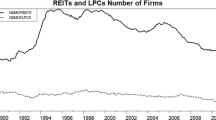Abstract
In this updated empirical analysis, investment risk models with infinite variance are more descriptive of distributions of individual property returns in the NCREIF database over the period 1980 to 2003 than Normally distributed risk models. Real estate investment risk is heteroskedastic, but the Characteristic Exponent of the investment risk function is nearly constant across time although differences among property types are evident. Accordingly, asset diversification is far less effective at reducing the impact of non-systematic investment risk on real estate portfolios than in the case of assets with Normally distributed investment risk. The patterns found in the U.S. are the same in Australia and the United Kingdom, and the Characteristic Exponents are virtually identical across all three countries.





Similar content being viewed by others
Notes
Before beginning the data analysis, each discrete annual sample return r t in the NCREIF database has been replaced with its continuously compounded logarithmic equivalent. Only properties having four quarters of data in a given calendar year have been included.
Alternatively, we could have disaggregated returns by major geographic region. However, property type is probably the superior cut, because it is more likely that investment characteristics of commercial property differ for properties with different drivers of economic performance than for properties with the same economic and functional attributes situated in different parts of the country. The free flow of institutional real estate investment capital across the U.S. over the past 30 years tends to homogenize transient differences in investment characteristics across geographical regions for property of the same type.
The assumption that α t > 1.0 guarantees that the mean of ɛ t (p) exists.
There are 51 “bins” in the histogram that span the range from minus to plus five standard deviations. Because some samples extend beyond this range, all the samples beyond plus or minus five standard deviations are included in the two extreme bins.
Since publication of McCulloch’s technique, maximum likelihood estimation (MLE) has gained favor for parameter estimation. In a test of MLE versus McCulloch on the aggregate NCREIF data set, the MLE results from the Mathematica modeling software were virtually identical to those produced by interpolation, so little more than speed of computation was gained using MLE. Thus, this note uses the McCulloch technique for consistency and comparability with prior work.
Of the four parameters that describe the stable distribution, the Characteristic Exponent is considered the most helpful for expressing the shape of the distribution. The Characteristic Exponent α lies in the half-open interval (0,2] and measures the rate at which the tails of the density function decline to zero. The larger the value of the Characteristic Exponent α, the faster the tails shrink toward zero. When α = 2.0, the distribution is Normal. While the means (first moments) of stable distributions with Characteristic Exponents α > 1.0 do exist, variances (second moments) do not exist—i.e., are infinite—for those distributions with Characteristic Exponents α < 2.0.
In the last decade or more, the conformity has become even more pronounced in the U.S. where almost all market participants use exactly the same analytical software, ARGUS.
References
Graff, R. A., & Young, M. S. (1999). The magnitude of random appraisal error in commercial real estate valuation. Journal of Real Estate Research, 17(1/2), 33–54.
Graff, R. A., Harrington, A., & Young, M. S. (1997). The shape of Australian real estate return distributions and comparisons to the united states. Journal of Real Estate Research, 14(3), 291–308.
McCulloch, J. H. (1986). Simple consistent estimators of stable distribution parameters. Communications in Statistics: Simulation and Computation, 15, 1109–1136.
Young, M. S., & Graff, R. A. (1995). Real estate is not normal: A fresh look at real estate return distributions. Journal of Real Estate Finance and Economics, 10(3), 225–259.
Young, M. S., Lee, S. L., & Devaney, S. P. (2006). Non-normal real estate return distributions by property type in the U.K. Journal of Property Research, 23(2), 109–133.
Author information
Authors and Affiliations
Corresponding author
Rights and permissions
About this article
Cite this article
Young, M.S. Revisiting Non-normal Real Estate Return Distributions by Property Type in the U.S.. J Real Estate Finan Econ 36, 233–248 (2008). https://doi.org/10.1007/s11146-007-9048-4
Published:
Issue Date:
DOI: https://doi.org/10.1007/s11146-007-9048-4




